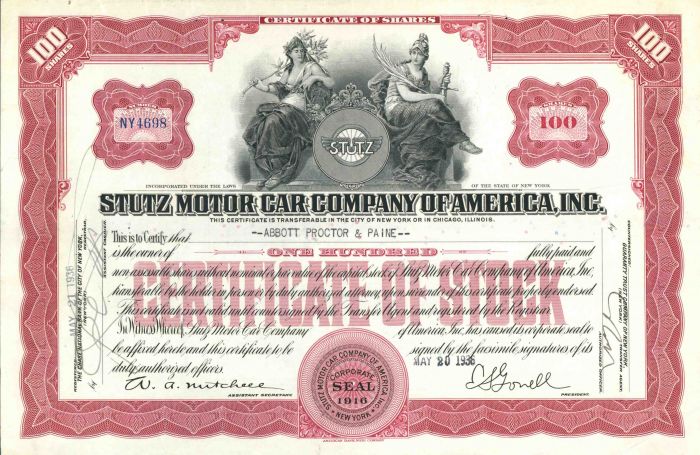Stutz Motor Car Co. of America, Inc. - 1936 dated Automotive Stock Certificate
Inv# AS1353 Stock
100 Share Stock Certificate Red printed by American Bank Note Company. Very Rare! The Stutz Motor Car Company was an American manufacturer renowned for producing high-end sports and luxury vehicles, headquartered in Indianapolis, Indiana. Its production commenced in 1911 and concluded in 1935. Stutz gained a reputation for creating fast automobiles, including the first sports car in America, and from 1924, it catered to the affluent with luxury models. The brand experienced a revival in 1968 under the Stutz Motor Car of America, introducing a series of modern vehicles with a retro aesthetic. Although the company remains operational, the production of factory-made cars ceased in 1995. The Ideal Motor Car Company, established in June 1911 by Harry C. Stutz and his associate, Henry F. Campbell, began manufacturing Stutz vehicles in Indianapolis the same year. This venture was initiated following the impressive performance of a car built by Stutz in less than five weeks, which secured 11th place in the Indianapolis 500, earning the tagline "the car that made good in a day." Ideal produced vehicles that were essentially replicas of the racecar, enhanced with fenders and lights, and marketed them under the model name Stutz Bearcat, named after the original racecar.
A stock certificate is issued by businesses, usually companies. A stock is part of the permanent finance of a business. Normally, they are never repaid, and the investor can recover his/her money only by selling to another investor. Most stocks, or also called shares, earn dividends, at the business's discretion, depending on how well it has traded. A stockholder or shareholder is a part-owner of the business that issued the stock certificates.










Ebay ID: labarre_galleries